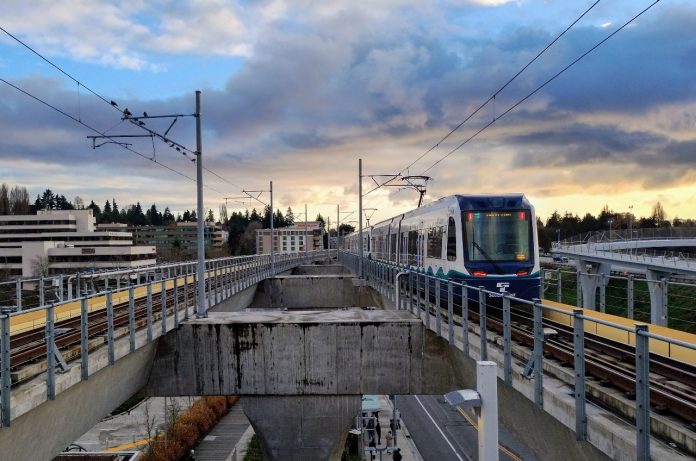
Big cost increases threaten the scope and timeline on the 4.1 mile light rail project, but are also casting a shadow over the entire ST3 program.
Days after the release of the Final Environmental Impact Statement (FEIS) megastudy for the West Seattle Link Extension project, Sound Transit revealed to the Seattle Times that the $1.1 to $1.6 billion in increased costs for the board’s preferred route was simply the tip of the iceberg. The agency’s more recent and thorough estimates put the projected overrun at $2.7 to $3.1 billion or between 67% and 77%, and it wasn’t clear how the agency’s board would react to this news.
Months before, the board had batted away a proposal, advanced by some of the region’s most powerful lobbying groups, to study a new option for the Ballard Link Extension project because the cost of delay was simply too high to abide. Would they press forward on West Seattle Link as well? Or explore other alternatives that could, in this case, trim costs?
Now, after two separate public briefings, it’s clear that the board is prepared to move ahead with West Seattle Link at full steam, without seriously considering alternative options, including an elevated alignment that could replace a costly tunnel underneath Alaska Junction. Even as the agency touts internal reforms that it says could bring some of these cost increases down to more manageable levels and help Sound Transit regain some ground, there are storm clouds brewing when it comes to the affordability of the entire Sound Transit 3 program.
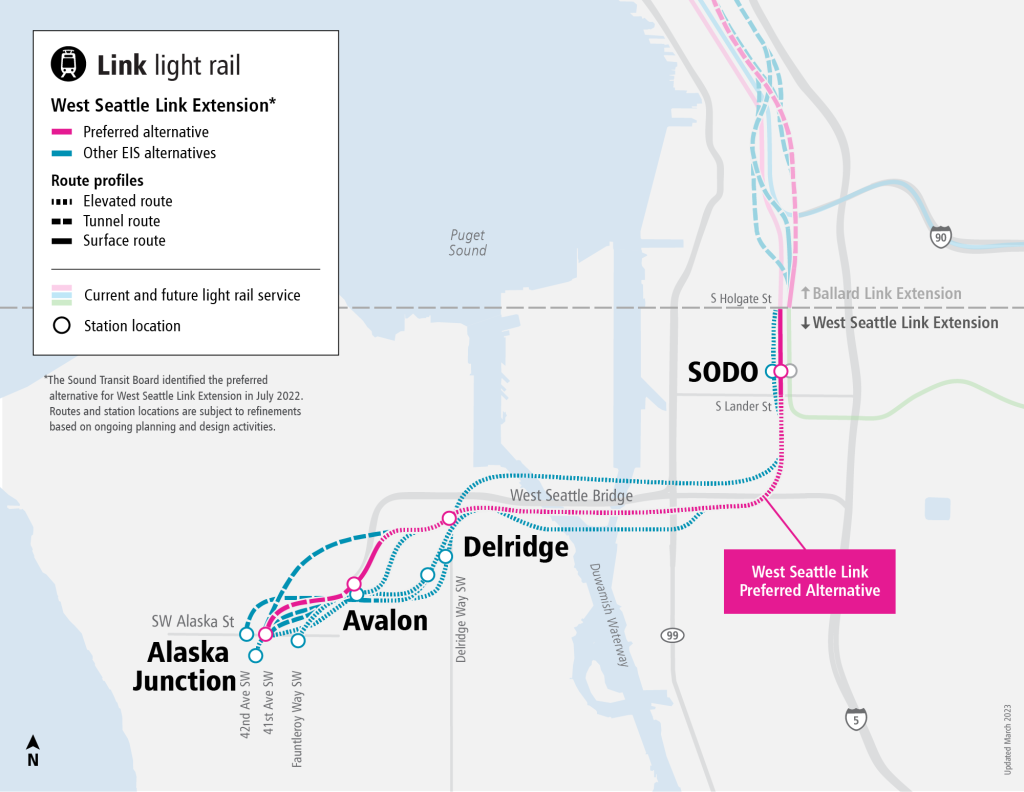
The lost 18 months for West Seattle Link
The $5.1-$5.6 billion cost estimate contained in West Seattle Link’s FEIS came as a surprise to Seattle residents, but had been known to Sound Transit for quite a while — apparently since March of 2023. That’s when Sound Transit developed all options to be studied to 10% level of design, and those designs reflected changes like moving piers for the planned Duwamish Waterway crossing out of the waterway, which adds costs, and a deeper station depth at Alaska Junction.
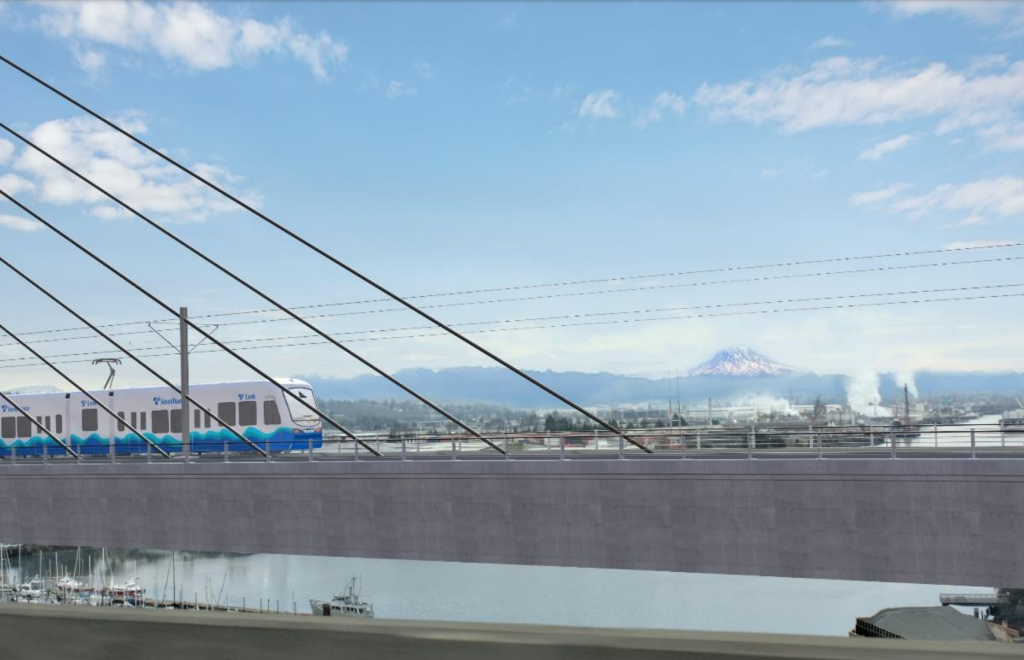
From that perspective, giving a second look to the Elevated Fauntleroy Way alternative might have seemed like a wise course of action. Switching away from the tunnel under 41st Avenue SW looked like it could reduce costs by $600 to $850 million. The board would have to carefully weigh the impacts of that, which is expected to include acquiring properties with significantly more residences, but that question wasn’t presented to the board. Instead, the 41st Avenue tunnel, the second most expensive option on the table, moved forward.
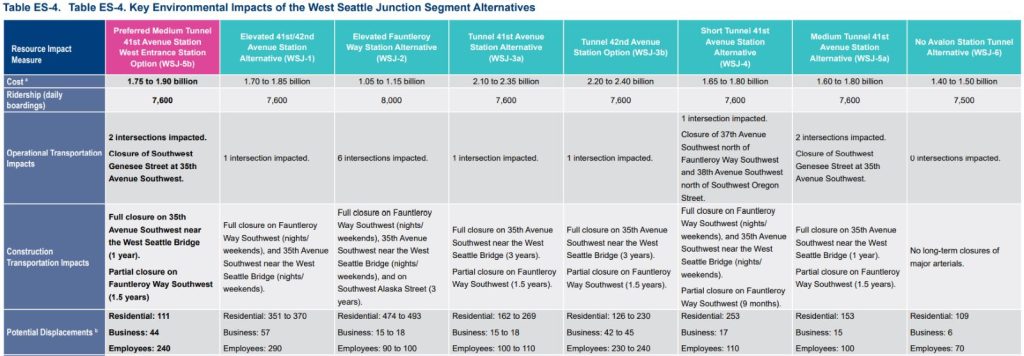
Now, the preferred alternative has been advanced to 30% design, and new “bottom-up” cost estimates peg the project at $6.7-$7.1 billion. Those bottom-up estimates entail a deep dive on specific project elements and site needs, and broader market conditions that are impacting large construction projects around the county, rather than blunter “unit cost” estimates the agency used in the FEIS. Unlike the 41st Avenue tunnel, an elevated Fauntleroy option wasn’t advanced to 30% design, so apples-to-apples comparisons are harder to make now.
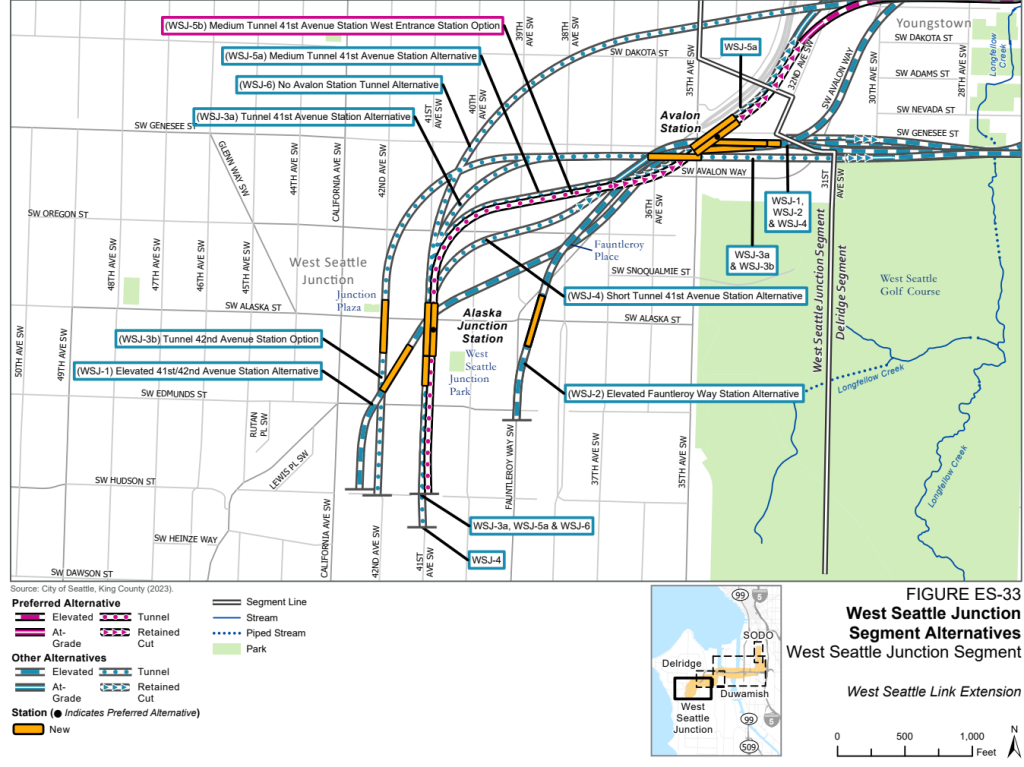
In an interview with The Urbanist, Sound Transit CEO Goran Sparrman and Terri Mestas, the agency’s new Deputy CEO for Megaprojects, suggested that even though other options like Fauntleroy haven’t been as fleshed out, the agency actually thinks that the differences between any of the options on the table have actually narrowed.
“The reality is that the kind of cost escalation we’re seeing on the preferred alignment, that is a largely driven by broader market forces, so I don’t know that we would expect to see significant lower cost in any other alternatives,” Sparrman said. “I wish there was a silver bullet there, but there isn’t, I don’t think.”
Mestas agreed. “I think we’re going to see those [increases] across the board, across all the alternatives, I think we’re going to see the same level of cost group,” she said. But ultimately it will be up to the Board to decide whether to explore scope changes to reduce costs. “If the Board wants us to explore other areas of scope, we certainly will.”
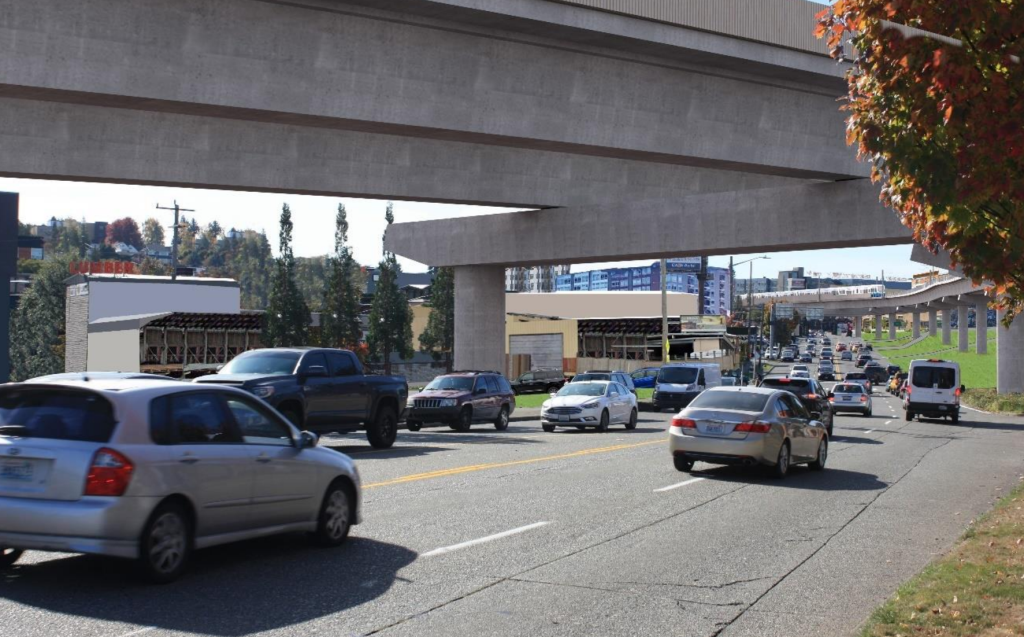
Ultimately, the cost of further delay to advance alternatives will weigh heavily on the board’s decision, all but assuring the 41st Avenue tunnel or bust approach. That change in mentality can be traced back to Sound Transit’s Technical Advisory Group (TAG), which has advised the agency reform the way it approaches megaprojects, with a message to the board that heavily emphasizes the need to avoid costly deliberating and micromanaging. Among the TAG suggestions was to hire a seasoned megaproject expert to oversee the agency’s portfolio, which led to the Mestas hire.
“If we were to go backwards and start changing the preferred alignment and have to go back and pick up [preliminary] engineering on a brand new alignment, that means a lot of time. And as you heard from the recent debate earlier this year around the South Lake Union Station issues, time equals money,” Sparrman said. “And on a big product like this, we’re talking a year delay [that] is worth hundreds of millions of dollars.”
Ironically, the agency’s default “representative project” initially included an elevated station on Fauntleroy Way and the agency had told the board that switching to a tunnel station would require “third-party funding” arranged by the City of Seattle, acknowledging the higher expected costs for tunneling. However, facing pressure from the board, the agency relented on requiring third party funding, helped by the fact that the Draft EIS cost estimates showed the elevated Fauntleroy station only slightly cheaper than the tunnel station the board selected — estimates which appear highly inaccurate in retrospect. That cleared the way for the board to catapult the 41st Avenue tunnel option into preferred alignment status.
Most of the Board seems to be falling in line behind the idea of advancing the more costly preferred alternative into the “project to be built” stage in October, with tough questions about total cost left to another day.
“I believe the most prudent thing to do is not to be paralyzed by this, not to be overwhelmed by it, but to keep moving and to get these projects designed so we understand what the trade offs are, what the hard choices the Board needs to make will be, and to have elements shovel ready when the market is ready for us,” Board chair Dow Constantine said earlier this month at a meeting of the Board’s executive committee.
That is not to say that there aren’t board members concerned about the impact that paying extra for projects like West Seattle will have on the overall system.
“We’ve got to focus on delivering ridership, not necessarily the nicest stations in the world or the biggest stations in the world. We’ve got to be disciplined in that, I am very concerned about the impacts to the north and the south,” Pierce County Executive Bruce Dammeier said this month.
More cost increases to come?
With eye-popping cost increases impacting West Seattle Link, the big question that’s mostly being left unanswered right now is what the state of the larger ST3 program looks like, in particular for West Seattle’s sister project, Ballard Link. The latest cost estimates peg the project at $11.2 billion for the second transit tunnel under Downtown Seattle and extension up to NW Market Street in Ballard. If the current cost trends for West Seattle hold elsewhere, Ballard Link could be headed for a big upward adjustment, but Sparrman and Mestas said it’s too early to know, and expressed optimism that strategies Sound Transit is working on will be able to keep costs down.
“Ballard’s earlier in the process […] we still have a good two years or so to get through the environmental process,” Mestas said. “That being said, there are some lessons learned from West Seattle and now that we’re going through this exercise of looking at these global strategies, we’re actually starting to apply them a lot earlier. So Ballard is going to benefit from that, and kind of going down this path and looking at a kit of parts and a little bit more consistency on how we deliver the program. So I think we’re going to get some efficiency there that we’re going to start to apply early.”
Most of the reasons behind the “cost growth” for West Seattle are tied to broader market conditions, and appear poised to impact any project that Sound Transit undertakes. At this month’s full board meeting, Lynnwood Mayor Christine Frizzell pressed Mestas on whether cost estimates for the entire ST3 program were likely to be 40% to 50% off from their current estimates.
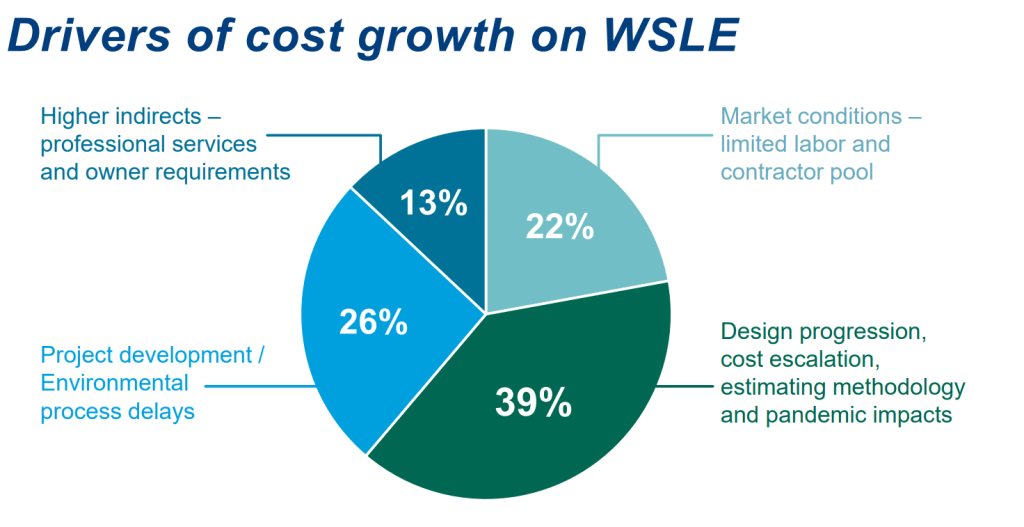
“I think it’s too soon to tell that,” Mestas said. “We are doing a lot of work now to estimate the projects in a different way. That being said, many of the projects are at their infancy, and there’s only very conceptual work that’s been done. The good news is that now we have a toolkit to be able to respond to this. We have some approaches like modular construction, the ability to use the station prototypes as we set out into the projects, as opposed to applying it later. So we’re going to apply that early, and then that’ll be accounted for these costs that we generate going forward as a project matures.”
But that new toolkit is likely to only go so far, as large transportation projects around the region and the country continue to escalate in cost well beyond simple inflation. With so many projects advancing toward construction at the same time, some type of realignment of priorities, similar to what happened in 2021, may be inevitable.
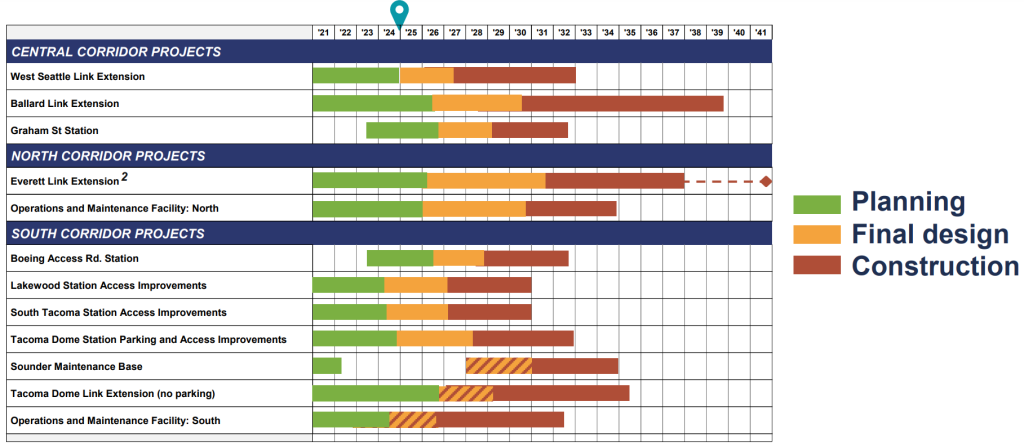
Sound Transit has not ruled out project timeline delays to make its more expensive projects fit into its financial plan, with the agency facing bonding capacity constraints as it advances so many projects in tandem.
“It’s really premature to speculate what that means on the capital side, whether that needs is we need to just cap the program,” Sparrman said. “At the end of the day, we are very fortunate. We have a well-funded capital program. They have overcome these kind of fiscal challenges before, and our job, frankly, is to deliver what we promised to voters. Exactly when and how that can happen, is what they have to adjust based on market conditions going forward.”
Sound Transit is hardly unique, since transit agencies and state transportation departments have faced cost escalations nationwide.
“The reality is that all our projects are facing these kinds of cost pressures,” Sparrman said. “It goes back to it’s the national market. It’s supplier contractors, supply of labor, supply chain issues, you name it. It’s all sort of working against us. So there’s no question that we as an agency in our capital program are facing some major headwinds.”
For now, the board is taking the advice to stick with its current course fairly seriously, but at some point soon it’s clear that Sound Transit leaders will have some tough decisions to make.
Ryan Packer has been writing for The Urbanist since 2015, and currently reports full-time as Contributing Editor. Their beats are transportation, land use, public space, traffic safety, and obscure community meetings. Packer has also reported for other regional outlets including Capitol Hill Seattle, BikePortland, Seattle Met, and PubliCola. They live in the Capitol Hill neighborhood of Seattle.


